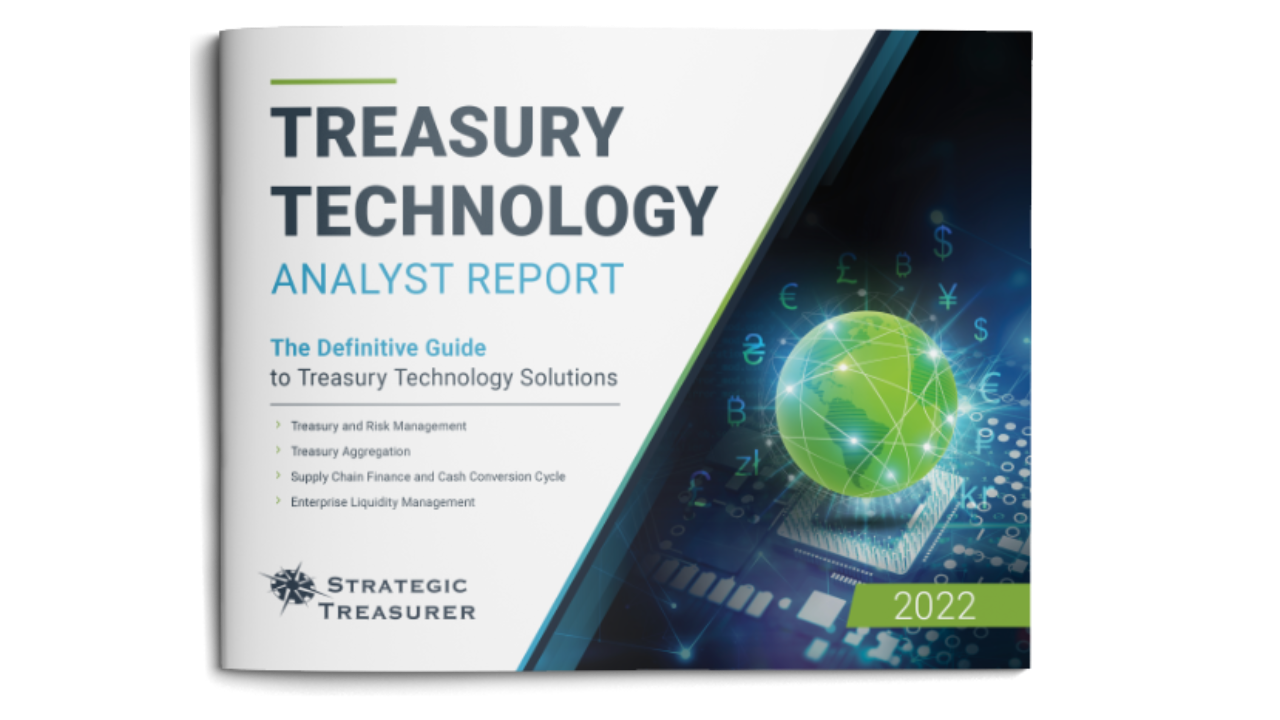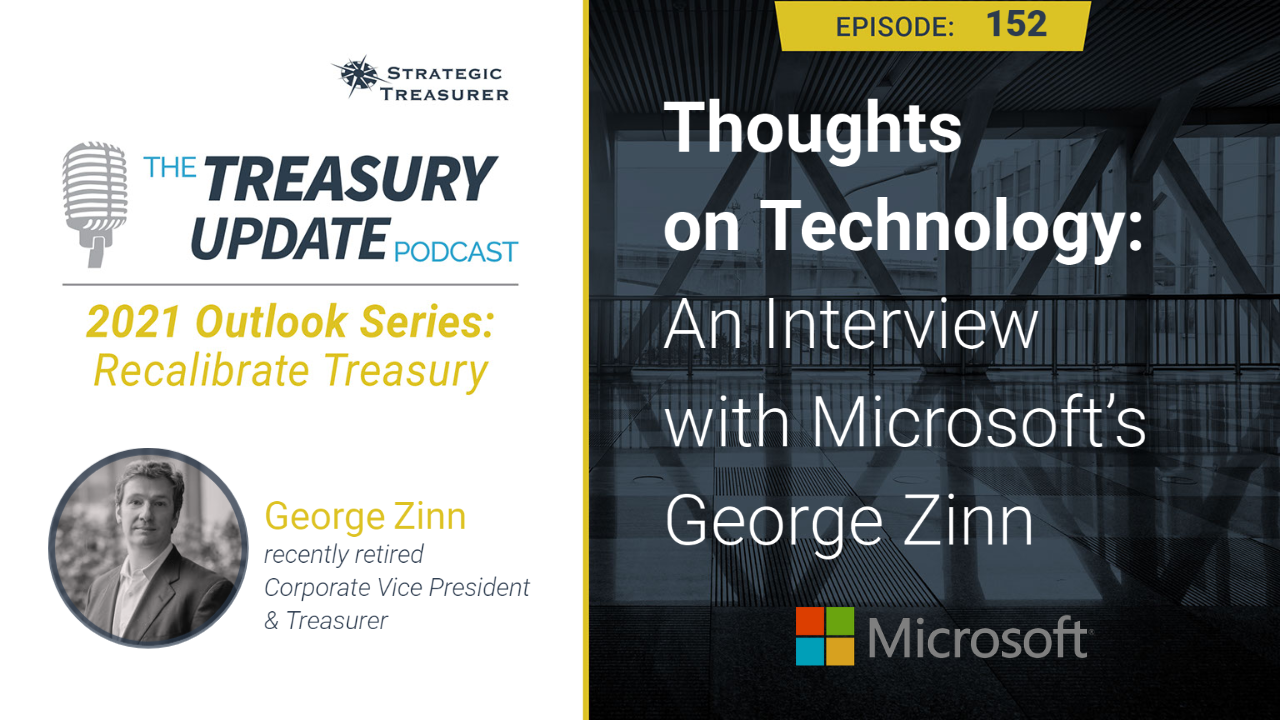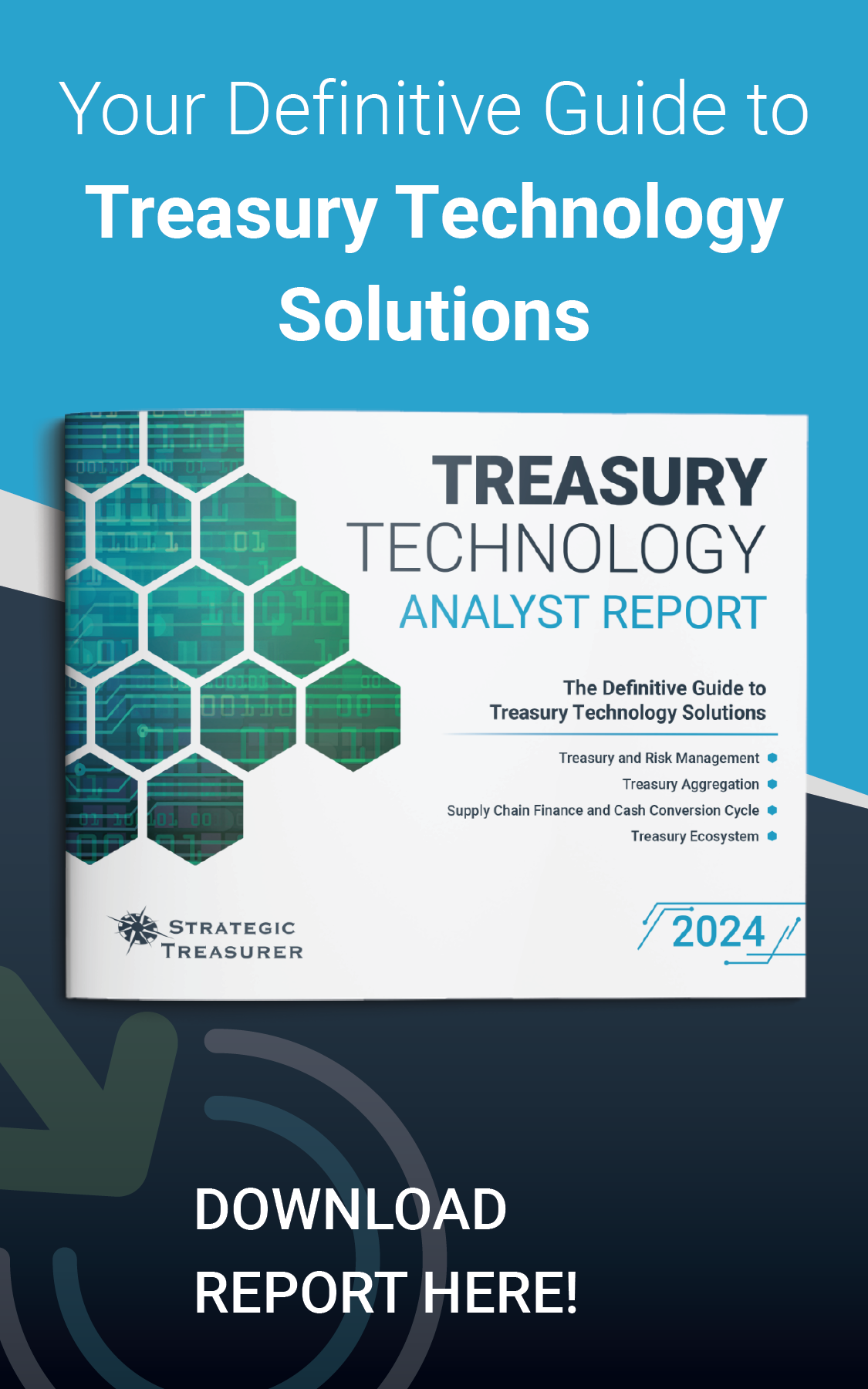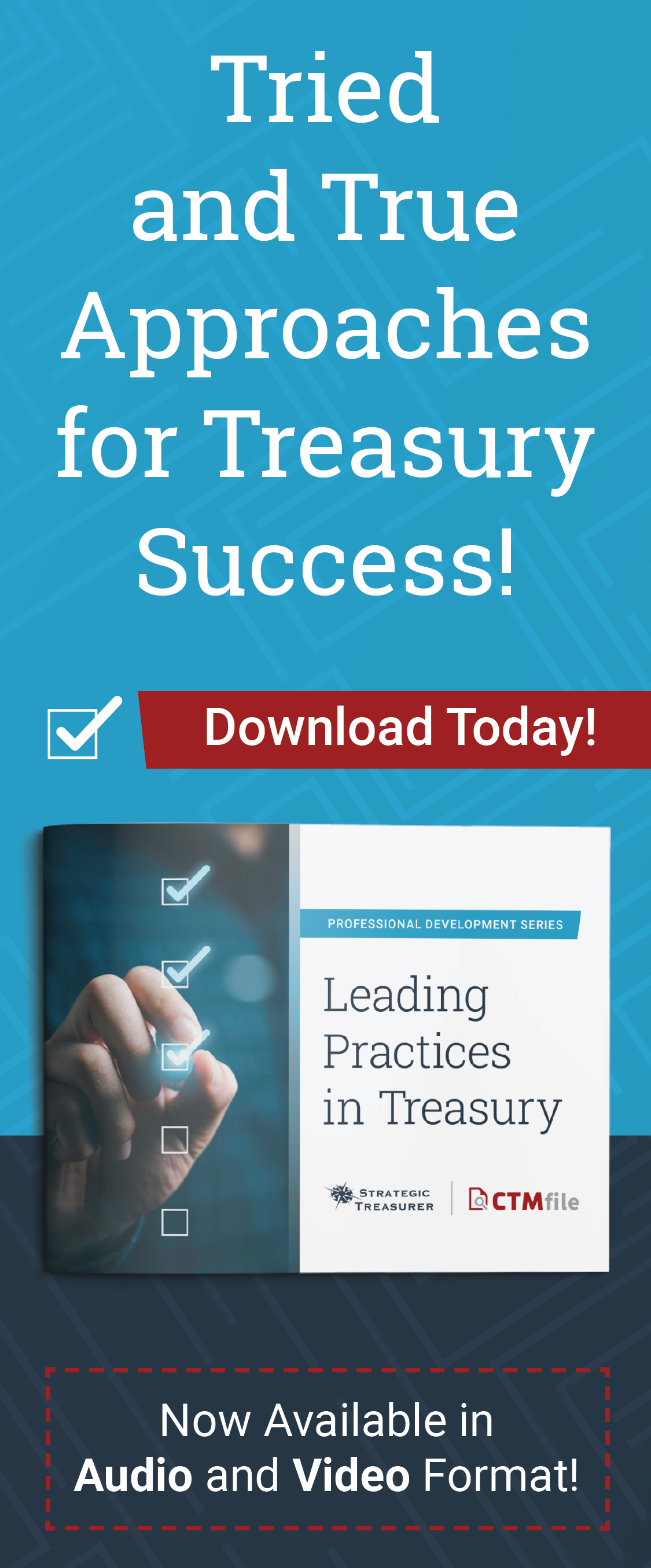
Episode 252
Fed Support and Bank Failures
Recent trauma in the financial sector brought down a $200B US bank in short order, with over $40B being pulled out on a single Thursday. Other banks have either failed or been rescued by the Fed and trillion-dollar banks. The pain is experienced well beyond the US too, with the forced marriage of two systemically important Swiss banks following SVB’s failure.
The Fed has promised to make depositors whole, so there has been no loss of funds or long-term freezing of balances for individuals or corporates. Does this represent unlimited and permanent insurance coverage by the Fed? They showed up for these events. When won’t they show up with coverage? Listen in as Craig Jeffery and George Zinn discuss these important topics.
Host:
Craig Jeffery, Strategic Treasurer

Speaker:
George Zinn, TreasuryGo

Episode Transcription - Episode #252 - Fed Support and Bank Failures
Announcer 00:04
Welcome to the Treasury Update Podcast presented by Strategic Treasurer, your source for interesting treasury news, analysis, and insights in your car, at the gym, or wherever you decide to tune in.
Craig Jeffery 00:19
Welcome to the Treasury Update Podcast. This is Craig Jeffery, your host today for an episode on Fed support for bank failures. I’m joined today by George Zinn. He’s a former Microsoft treasurer, and he’s the current president of TreasuryGo. Welcome to the Treasury Update Podcast. George.
George Zinn 00:38
Great to be here, Craig. Thanks.
Craig Jeffery 00:41
So, when we think about fed support, and bank failures, recent trauma in the financial sector brought down a $200 billion US Bank in very short order. With over $40 billion dollars being wired out on a single Thursday. Other banks have either failed or been rescued by the Fed or by trillion dollar banks redepositing billions to shore up those other banks. The pain is experienced well beyond the US with a forced marriage with two systemically important Swiss banks following the SVB debacle. The Fed has promised to make depositors whole in the situation. So there hasn’t been a loss of funds, or long term freezing of balances for individuals or corporations. Does this represent an unlimited and permanent insurance coverage by the Fed? They showed up for these events? When Won’t they show up with coverage? George, I’m so glad to have you on today’s podcast.
George Zinn 01:33
Great. I would like to just go over the arc of time to I think kind of quickly explain and not really rehash the news cycle of my perspective on SPV. The Greenspan put began in 87, with the crash and veteran, you know, traders were very surprised how quickly the markets came back in that situation. And, you know, we’ve had various instances of what now become called the Fed put, one that people might have forgotten about as long term capital management, where they were bailed out, that increase in liquidity led to, you know, some, some say, primarily, drove the NASDAQ bubble, which was, again, a bust launch, credit conditions started to tighten. And so we’ve seen the cycles. We’ve also seen the, I think, a particularly after the credit crisis, the change of attitudes of the US taxpayer and bailing out banks and, and the government acting as the insurer, when you insure something, there are data points that as a as properly insured person, I will drive my car faster. And that is simply a metaphor for taking greater risk. At this juncture, I think we have a particularly an interesting data point was that as I understand that the government when they were determining over the weekend, whether or not they would provide this backstop, particularly for deposits greater than 250,000 was a discussion that it can’t cost the taxpayer anything, I think that was a very fundamental tenant of the Biden administration. This is a really, I think, honestly, a little bit of a shell game, because the FDIC, I’ve seen a number, let’s call it 20 billion. So it’ll cost the FDIC 20 billion round numbers we’re not debating it’s got to be. And the reality is, and the way the FDIC stay solvent, is they provide assessments to their, you know, member member banks, effectively their insurance policy. And at the end of the day, we know that banks are not 501, C threes, right? So where do you think that money is going to come from, it’s going to be coming from the taxpayers pocket in a reduced rate return on his savings account or her savings account, as well as, you know, potentially incremental fees that you can’t keep track of. But I do believe that, that in the at the end of the day, the US taxpayer is footing the bill. And the real question is, at what point you know, the discussion in the credit crisis was at what point is there a bank too big to fail? And you moved us to the Credit Suisse UBS situation. And it might be that in that situation, those the the one bank was you’re systematically important, but it was possibly too big to save. So the forced marriage was basically wiping out the 81 credit people as well as the equity. So it was not a full on Fed put, let’s call it.
Craig Jeffery 04:59
Central bank, yeah.
George Zinn 05:00
Yeah, exactly. And so I do think that, you know, if we see the credit cycle continue to tighten, and we see, you know, quantitative tightening by the Powell administration, we are going to see sort of one of the results of this situation, where we’re going to have more distressed borrowers credit is going to be tighter, we end up in a situation where it may just be that, you know, the insurance is too expensive to bring to the table. And so for certain sectors, like commercial real estate, or private equity, which doesn’t tend to have a huge, you know, popular voting base, you know, those types of places, if they, if they can’t raise capital, and PE and VC firms have to raise, you know, liquidity by selling equity, they’re going to take some very probably steep discounts in their valuation, which obviously, then nobody would want to do. I think that the one thing that I would say, that is different from this good old, good old fashioned bank run, as it’s been called, is not just a moral hazard, but the digitisation, how do you go bankrupt? Very slowly, then all at once. They, there were some telltale signs that needed to be addressed, before someone shouted fire in the theater. And they had everybody ran for the doors. One of the signs was out of the Great Depression, one of the things that was created was the Federal Home Loan Bank. And basically, what that bank does, is they provide advances to banks. And in this scenario, they did just that for several months before even the crescendo. The challenge with the Federal Home Loan Bank advances is they charge somewhere between four, four and a half 5%. So it’s not a sustainable way to necessarily run your business, I guess is the right way to say it. If you think about your, one of the challenges that various places, including Schwab was experiencing, experiencing these, you know, crisis of confidence. And as you reached a certain point where the liabilities actually exceeded the assets, and they really couldn’t, you know, sell what is supposedly the most liquid asset in the world, their treasuries for various reasons. All of this kind of snowballed into what I think is one of the more significant and less talked about aspects of this good old fashioned background is, let’s just call it digitization. So the rapidity of the people’s ability to move money and move accounts, is unmatched. Now, I think that is one of the less talked about aspects of this. I think it’s, you know, interesting. It means you have to stop.
Craig Jeffery 08:11
When you talk about the the rapidity today versus during the crash in 1929. You see all these pictures of people lined up around the banks like in like over a period of weeks, everyone kept withdrawing funds until they ran out of money. And, you know, as we said in the intro, like 40 42 billion was wired out in one day. Like that is that is not just a bank run, that is a sprint, it’s a cyber sprint, like it’s, it’s like almost instantaneous. So I think your point is really, really important that it’s not like it happens slowly. And then all at once it happens, like, slowly and then, like you said, instantaneously, I think that’s, I guess you said the perfect way there.
George Zinn 08:52
So, I mean, relative to what I think would be interesting to your listeners would be sort of the, you know, the practitioners perspective. So if we acknowledge that we’re in a tightening in the credit cycle, how should we approach life? And how should we mitigate the risk of being one of the people that don’t get out of the theater? In another replay of the similar situation?
Craig Jeffery 09:24
I think I think you’re right there. I think that is a good part of the discussion. You know, the, the idea is like, if if the insurer always shows up, there’s not much to worry about, right? There’s no moral hazard. There’s no financial risk. But what happens when that isn’t the case? And you know, some of these rescues have been the central banks like in the Fed or, you know, in Switzerland, they’re stepping in. There’s been some other examples in the US where some of the trillion dollar banks the largest banks have stepped in and redeposited money that fled other banks into theirs. They come and redeposit it in and on insured weigh in those other banks shoring them up. So as money flies out, it flies back in. And those banks are protected, you know, and that that could be without getting into that too much. That could be some of the banks don’t want to face the risk that they faced when they saved other banks in the past. They could say, well, can we take it over? We can have other exposures that we didn’t want. If we save a bank, that’s that’s failing, we do a merger. And so this seems to be lower risk for some of those. I don’t I don’t know if you’ve had any thoughts on that. That topic?
George Zinn 10:32
I guess I was going into the practitioners perspective, if you want it to revert to the macro. I think there’s, you know, some interesting signposts that say that, you know, we have turned, effectively have turned banks into utilities in a way that is difficult to explain what the way banks make money is they get deposits, in the simplest sense. And then they make investments or loans, usually, in a longer dated fashion. And the classic, you know, situation here is as deposits began to disappear, and it wasn’t just in the last couple of weeks, it was people actually wanting to earn more than just half a percent on their savings account, because the alternative the two year Treasury with a four and a half, that, you know, money market funds were tremendous beneficiaries of the outflows, as well as some of the other companies out there. I think you’re familiar with one and the other one prime and Tory in my time became intra fie. And they have a way to diversify your bank accounts, by spreading them around, not exceeding the $250,000, or even putting them into their cedars program, which is certificate deposits. So I think there’s a number of things that practitioners can do, obviously, I’m a little biased at Treasury go, we have a bank administration module. And literally, we download closing us Silicon Valley Bank account, and it takes about 10 to 15 minutes before you’d be able to move everything over to another outfit that seemed less risky. This end and workflow process with a virtual approval processes, does ensure better controls and increase productivity. But you know, at the end of the day, it’s also eliminating manually repetitive tasks and freeing up time for value added work. So this, this software was originally developed when I was back at Microsoft, so I actually really believe in terms of what it can do.
Craig Jeffery 12:45
So George, you know, we we talked about these things like, you know, having multiple banks able to be diversified, sweeping amounts over 250,000. Using ideas like some of the ones we talked about, you know, what else should should we be thinking about, in addition to this, being prepared, able to move quickly, like you mentioned with Treasury go? Yeah, anything anything else that we should be thinking about?
George Zinn 13:10
Well, the challenge, I recall, in the credit crisis, when we were repeatedly getting asked questions about, you know, what the latest acronym was, and whether or not we had invested in it, whether we held it, and it really turned into a very obvious to me that you needed to get your data squared away, and the situation where you weren’t doing it in a automated fashion. It meant that you had to go gather from PowerPoints and excel sheets, and everything that slowed you down. And ironically, in the effort of trying to get it right, you extended the duration of your response, then people who were asking the questions from on high assumed something was wrong, and would ask more questions, perpetuating the cycle. For example, since we’re talking about bank account administration, the ability to know very quickly at the click of a button, how many accounts you have at a particular bank, who the signers are, who the approvers are to move them what the process is, being integrated with your email is all really making you much more agile. That is not possible in spreadsheets, which is how most people are tracking this type of information. When so once you’re less agile, because you don’t have a good handle on your data, you end up being the one stuck in the theater is my analogy I guess for the call.
Craig Jeffery 14:52
Yeah, this this idea you know your first point is like you have to see where where’s my money? What accounts do I have if a certain banks on the radar? Any Counterparty? What do I have there? How would I act on it, and then being able to move quickly making the decision and moving in a reasonable, reasonable timeframe, if I reduce my exposure, I still may need to act, I still may need to move this activity. And I do like your, your analogy on the on the theater side. In 2008 2009, counterparty risk was very, very important. And in the intervening decade, plus, that’s kind of slid down the list a bit. It’s it’s not, it wasn’t it’s not the top one or two, three, until about, you know, four weeks ago. And all of a sudden, it’s like, Whoa, that is that is really important. We really need to see that, that warning sign that we can look at, when I look at that, it’s like it’s always we’ll build houses on floodplains, and then be surprised when the flood comes in, then we’re all careful. Nobody does things that we go back there, that this continues to, there’s a cycle that we go back to it, we ignore the fact that risks are still there, though they may not happen every four years, eight years, 15 years. This I think, too, is another thing, not just see where our funds are, but were exposures are and what level of exposure exists.
George Zinn 16:16
That’s a great analogy. The FEMA analogy is very similar to I think the FDIC analogy and the Fed relative to banks and the banking sector, the comment on counterparty risk, I know that we really did take it seriously, we were adding not just our investments and our deposits together. So to the extent you held, you know, fill in the blank bank, note in your investment portfolio that was added to the deposit number. And then we’d also pull in the AR exposure, accounts receivable exposure. And we call that our 360 degree report. At the time, I think you we have to recall that that was one of the weeks you were making your contingency plan for one of the big banks not being there. So you wanted to figure out payroll and plan B was like Bank of America. And so the next weekend, they were the one that wasn’t going to be there. So you had to make a plan C. So I think that it was, you know, top of mind much more than it is today. But it’s also I think it goes back to a little bit of the moral hazard question. Because the expectation is that the Fed will swoop in and to, quote, Draghi do whatever it takes. And I think at some point, there’s a inability to continue to extend that kind of liquidity. Given the cycles, we’re in over over time. As I said earlier, it just may be very similar to the Swiss example where you find a situation where they’re not too big to fail, they’re too big to save. And so they only extend a limited amount of a lifeline in order to, you know, not unlike what what occurred in the credit crisis with JP Morgan taking over Washington Mutual. Bank of America, Wachovia.
Craig Jeffery 18:25
Yeah, and GM. I mean, just the, the rescue, the saves, they, they look very different. Like you said, the moral hazard can be, oh okay, there was no moral hazard, right? Or apparently very little, at times. And then in other cases, it’s okay, you’ve lost, you’ve lost money, we’ve lost access to it for a certain period of time.
George Zinn 18:45
Absolutely. I mean, it is it really, I think, what what we’re trying to highlight here is that you got to read the fine print on your insurance policy. Because you just might not be covered in a certain eventuality.
Craig Jeffery 19:01
You, you might not be covered, I think I think we need to assume to corporate treasurers have to assume they won’t be covered. And so you have to set up things ahead of time, you have to be prepared. And you have to have the tools in place, anything else is not responsible. I think that’s I think that’s what we have to say, you know, across the board, being prepared, ready and able to act.
George Zinn 19:23
Yeah. So I think, you know, organized data, and diversified accounts. And as you said, not relying on incremental help in your insurance policy.
Craig Jeffery 19:38
George, great points. Thanks for for joining me on the podcast and, and for those who are listening. If you want to get in touch with George, he’s at George@TreasuryGo.com. You’ll see that in the show notes. George, thanks. Thanks a lot.
George Zinn 19:53
Thanks for having me, Craig. It’s great.
Announcer 19:57
You’ve reached the end of another episode of the Treasury Update Podcast. Be sure to follow Strategic Treasurer on LinkedIn. Just search for Strategic Treasurer. This podcast is provided for informational purposes only, and statements made by Strategic Treasurer LLC on this podcast are not intended as legal, business, consulting, or tax advice. For more information, visit and bookmark StrategicTreasurer.com.
Subscribe to the Treasury Update Podcast on your favorite app!
Related Resources
Researching new treasury and finance technology can be overwhelming. Strategic Treasurer has stepped in to help. Explore our definitive guide to the treasury technology landscape and discover detailed, data-based coverage of each area.
Thoughts on Technology: An Interview with Microsoft’s George Zinn
Host Craig Jeffery interviews George Zinn, Microsoft’s recently retired Corporate Vice President & Treasurer. They explore his career journey in treasury, reflect on technology across several decades, and discuss his perspective on what differentiates aspiring treasurers. Listen in to this engaging conversation to find out more.








